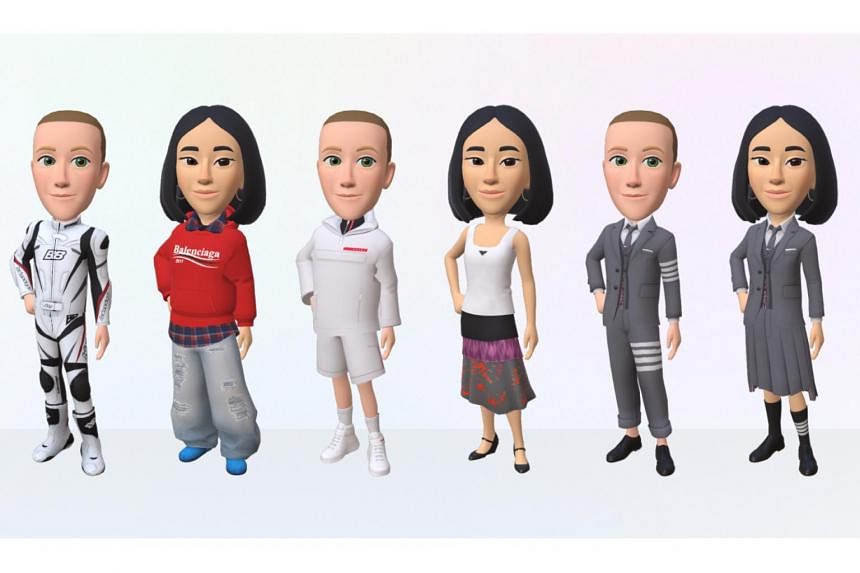NEW YORK (NYTIMES) - So that's it.
In October, after Mark Zuckerberg had unveiled his vision for the new Meta (formerly Facebook) and the amazing future that awaited in Web 3.0, and been roundly teased for his decision to do so via an avatar wearing exactly the same thing Zuckerberg wears in his everyday life - this, in a world of infinite possibility - Meta picked up on the problem and threw down a gauntlet of sorts.
"Hey, Balenciaga," the company tweeted, "What's the dress code in the metaverse?"
This week Balenciaga responded, along with Prada and Thom Browne, courtesy of Meta's new avatar fashion store, which began a rollout to users in the United States, Canada, Thailand and Mexico. Though the social media company had offered a variety of free (and generic) outfits for avatars used on Facebook, Instagram and Messenger, this is the first time it has enlisted named designers to create looks-for-purchase for virtual selves.
And the answer is … a red Balenciaga logo hoodie.
Also some ripped jeans and a plaid shirt, a motocross jumpsuit, a black skirt suit, and low-rise jeans paired with a crop logo tee and logo briefs.
Quintessential Balenciaga looks, in other words, for anyone who has followed the brand. Just as Thom Browne's offering, a shrunken grey three-piece suit, pleated gray skirt suit and shorts outfit, is Browne's trademark uniform. And as at least one of Prada's four looks - a white tank top with logo triangle and tiered skirt - seemed to come straight from the most recent runway.
But still, that's it?
These are four of the most creative, considered fashion designers working today - Demna of Balenciaga, Miuccia Prada and Raf Simons of Prada, and Browne - designers whose clothes IRL grapple with the way social and political forces shape identity at the most essential levels; designers whose work has tackled climate change, gender, war, capitalism, questions of value and viral celebrity. And all they (or maybe their digital, merchandising and marketing teams) could come up with when tasked to imagine dress in a space unbound by gravity and any kind of physical limitation are cartoon copies of among the most familiar clothes they already sell?
Well, Browne e-mailed when asked how he chose his outfits, "it took me two seconds, no one second, to know what it needed to be. I thought the grey suit needed to engage in this world".
The argument is that simply by making these clothes, which normally sell for hundreds and thousands of dollars, available to a wider group of users (in the Meta store the price range is US$2.99 (S$4.15) to US$8.99), they are democratising the otherwise inaccessible. Which is true, commercially speaking, and essentially positions the Meta looks as the NewGen equivalent of a lipstick: the ultimate in diffusion lines, almost all barriers to entry erased.
The whole point of the kind of fashion that Demna, et al., create is that it is more than commercial: It shows us who we are, or who we want to be, at a specific moment in time in ways we didn't even understand until we see it.
Yet what the "clothes" this troika have designed for the Meta store show seem to be, largely, are an opportunity to show off brand allegiance and leverage their archives in the most straightforward ways.
In a Facebook post on the store, Zuckerberg also said that Meta wanted to create an avatar fashion offering because "digital goods will be an important way to express yourself in the metaverse and a big driver of the creative economy." But self-expression is not about swallowing a designer look whole. Self-expression is about using the tools designers create to make something individual.
However, if you want the virtual you to wear Prada - or Balenciaga or Thom Browne - you can do it only on Meta platforms. Just as if you wanted the virtual you to wear Tommy Hilfiger, Ralph Lauren or Gucci, you have to be on Roblox.
Zuckerberg has said that at some point Meta will open the store to digital-only fashion brands and other new creatives - the sort of designer/inventors already selling their wares on the digital marketplace DressX, which is where most of the truly alternative interpretations of "clothes" can be found.
If so, getting your avatar dressed in the morning may feel less like playing paper dolls, and more like a unique form of value-signaling and experimentation; may seem additive, rather than just imitative. But not yet.

